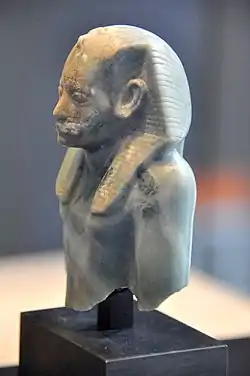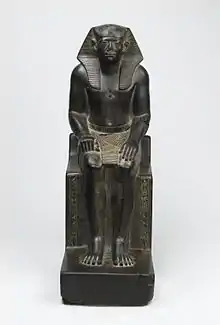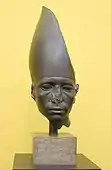Twelfth Dynasty of Egypt
The Twelfth Dynasty of ancient Egypt (Dynasty XII) is considered to be the apex of the Middle Kingdom by Egyptologists. It often is combined with the Eleventh, Thirteenth, and Fourteenth dynasties under the group title, Middle Kingdom.
Twelfth Dynasty of Egypt | |||||||||
|---|---|---|---|---|---|---|---|---|---|
| 1991 BC – 1802 BC | |||||||||
 | |||||||||
| Capital | Thebes, Itjtawy | ||||||||
| Common languages | Egyptian language | ||||||||
| Religion | ancient Egyptian religion | ||||||||
| Government | Absolute monarchy | ||||||||
| Historical era | Bronze Age | ||||||||
• Established | 1991 BC | ||||||||
• Disestablished | 1802 BC | ||||||||
| |||||||||
| Periods and Dynasties of Ancient Egypt |
|---|
|
All years are BC |
|
See also: List of Pharaohs by Period and Dynasty Periodization of Ancient Egypt |
History
The chronology of the Twelfth Dynasty is the most stable of any period before the New Kingdom. The Turin Royal Canon gives 213 years (1991–1778 BC). Manetho stated that it was based in Thebes, but from contemporary records it is clear that the first king of this dynasty, Amenemhat I, moved its capital to a new city named "Amenemhat-itj-tawy" ("Amenemhat the Seizer of the Two Lands"), more simply called, Itjtawy.[1] The location of Itjtawy has not been discovered yet, but is thought to be near the Fayyum, probably near the royal graveyards at el-Lisht.[2]
The order of its rulers of the Twelfth Dynasty is well known from several sources: two lists recorded at temples in Abydos and one at Saqqara, as well as lists derived from Manetho's work. A recorded date during the reign of Senusret III can be correlated to the Sothic cycle,[3] consequently, many events during this dynasty frequently are able to be assigned to a specific year.
Rulers
| Name | Horus (throne) name | Image | Date | Pyramid | Queen(s) |
|---|---|---|---|---|---|
| Amenemhat I | Sehetepibre | 1991 – 1962 BC | Pyramid of Amenemhet I | Neferitatjenen | |
| Senusret I (Sesostris I) | Kheperkare |  | 1971 – 1926 BC | Pyramid of Senusret I | Neferu III |
| Amenemhat II | Nubkhaure |  | 1929 – 1895 BC | White Pyramid | Kaneferu Keminub? |
| Senusret II (Sesostris II) | Khakheperre | 1897 – 1878 BC | Pyramid at El-Lahun | Khenemetneferhedjet I Nofret II Itaweret? Khnemet | |
| Senusret III (Sesostris III) | Khakaure |  | 1878 – 1839 BC | Pyramid at Dahshur | Meretseger Neferthenut Khnemetneferhedjet II Sithathoriunet |
| Amenemhat III | Nimaatre |  | 1860 – 1814 BC | Black Pyramid; Pyramid at Hawara | Aat Hetepi Khenemetneferhedjet III |
| Amenemhat IV | Maakherure | -BritishMuseum-August19-08.jpg.webp) | 1815 – 1806 BC | Southern Mazghuna pyramid (conjectural) | |
| Sobekneferu | Sobekkare | .jpg.webp) | 1806 – 1802 BC | Northern Mazghuna pyramid (conjectural) |
Known rulers of the Twelfth Dynasty are as follows:[4]
Amenemhat I
This dynasty was founded by Amenemhat I, who may have been vizier to the last king of Dynasty XI, Mentuhotep IV. His armies campaigned south as far as the Second Cataract of the Nile and into southern Canaan. He also reestablished diplomatic relations with the Canaanite state of Byblos and Hellenic rulers in the Aegean Sea. He was the father of Senusret I.
Senusret I
Senusret I followed his father's triumphs with an expedition south to the Third Cataract.
Amenemhat II
Amenemhat II was king during a very peaceful time.
Senusret II
Senusret II also was content to live in peace.

.jpg.webp)

Senusret III
Finding Nubia had grown restive under the previous rulers, Senusret sent punitive expeditions into that land. He also sent an expedition into the Levant. His military campaigns gave birth to a legend of a mighty warrior named Sesostris, a story retold by Manetho, Herodotus, and Diodorus Siculus. Manetho claimed the mythical Sesostris not only subdued the lands as had Senusret I, but also conquered parts of Canaan and had crossed over into Europe to annex Thrace. However, there are no records of the time, either in Egyptian or other contemporary writings that confirm Manetho's additional claims.
Amenemhat III
Senusret's successor Amenemhat III reaffirmed his predecessor's foreign policy. However, after Amenemhat, the energies of this dynasty were largely spent, and the growing troubles of government were left to the dynasty's last ruler, Sobekneferu, to resolve. Amenemhat was remembered for the mortuary temple at Hawara that he built, known to Herodotus, Diodorus, and Strabo as the "Labyrinth". Additionally, under his reign, the marshy Fayyum was first exploited.
Amenemhat IV
Amenemhat IV succeeded his father, Amenemhat III, and ruled for approximately nine years.
Sobekneferu
Sobekneferu, a daughter of Amenemhat III, was left with the unresolved governmental issues that are noted as arising during her father's reign when she succeeded Amenemhat IV, thought to be her brother, half brother, or step brother.[5] Upon his death, she became the heir to the throne because her older sister, Neferuptah, who would have been the next in line to rule, died at an early age. Sobekneferu was the last king of the twelfth dynasty. There is no record of her having an heir. She also had a relatively short reign and the next dynasty began with a shift in succession, possibly to unrelated heirs of Amenemhat IV.[6]
Ancient Egyptian literature refined
It was during the twelfth dynasty that Ancient Egyptian literature was refined. Perhaps the best known work from this period is The Story of Sinuhe, of which several hundred papyrus copies have been recovered. Also written during this dynasty were a number of didactic works, such as the Instructions of Amenemhat and The Tale of the Eloquent Peasant.
Also, the kings of dynasties twelve through eighteen are credited with preserving for posterity some of the most remarkable Egyptian papyri that have survived to today:
- 1900 BC – Prisse Papyrus
- 1800 BC – Berlin Papyrus
- 1800 BC – Moscow Mathematical Papyrus
- 1650 BC – Rhind Mathematical Papyrus
- 1600 BC – Edwin Smith papyrus
- 1550 BC – Ebers papyrus
See also
| Wikimedia Commons has media related to 12th dynasty of Egypt. |
References
- Arnold, Dorothea (1991). "Amenemhat I and the Early Twelfth Dynasty at Thebes". Metropolitan Museum Journal. The Metropolitan Museum of Art. 26: 5–48. doi:10.2307/1512902. JSTOR 1512902.
- Shaw, Ian, ed. (2000). The Oxford History of Ancient Egypt. Oxford: Oxford University Press. p. 159.
- Parker, Richard A., "The Sothic Dating of the Twelfth and Eighteenth Dynasties," in Studies in Honor of George R. Hughes, 1977
- Aidan Dodson, Dyan Hilton: The Complete Royal Families of Ancient Egypt. The American University in Cairo Press, London 2004
- Dodson, Hilton, The Complete Royal Families of Egypt, 2004, p. 98.
- Ryholt, The Political Situation in Egypt during the Second Intermediate Period (1997), p. 15.
| Preceded by Eleventh Dynasty |
Dynasty of Egypt 1991 − 1802 BCE |
Succeeded by Thirteenth Dynasty |